
Juno or Juno Beach was one of five beaches of the Allied invasion of German-occupied France in the Normandy landings on 6 June 1944 during the Second World War. The beach spanned from Courseulles, a village just east of the British beach Gold, to Saint-Aubin-sur-Mer, and just west of the British beach Sword. Taking Juno was the responsibility of the First Canadian Army, with sea transport, mine sweeping, and a naval bombardment force provided by the Royal Canadian Navy and the British Royal Navy as well as elements from the Free French, Norwegian, and other Allied navies. The objectives of the 3rd Canadian Infantry Division on D-Day were to cut the Caen-Bayeux road, seize the Carpiquet airport west of Caen, and form a link between the two British beaches on either flank.
The Overlord Embroidery, echoing the Bayeux Tapestry created 900 years before to commemorate the reverse invasion of England from Normandy, is a narrative embroidery that depicts the story of the D-Day Landings of 6 June 1944 and the subsequent Battle of Normandy. The story is told across 34 hand stitched panels running in total to 83 metres in length. The embroidery was created between 1968 and 1974, and is now on permanent display at The D-Day Story, Southsea, Portsmouth.

Landing craft are small and medium seagoing watercraft, such as boats and barges, used to convey a landing force from the sea to the shore during an amphibious assault. The term excludes landing ships, which are larger. Production of landing craft peaked during World War II, with a significant number of different designs produced in large quantities by the United Kingdom and United States.

A beach armoured recovery vehicle (BARV) is an armoured recovery vehicle used for amphibious landings.
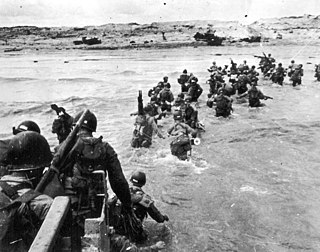
Utah, commonly known as Utah Beach, was the code name for one of the five sectors of the Allied invasion of German-occupied France in the Normandy landings on June 6, 1944 (D-Day), during World War II. The westernmost of the five code-named landing beaches in Normandy, Utah is on the Cotentin Peninsula, west of the mouths of the Douve and Vire rivers. Amphibious landings at Utah were undertaken by United States Army troops, with sea transport, mine sweeping, and a naval bombardment force provided by the United States Navy and Coast Guard as well as elements from the British, Dutch and other Allied navies.
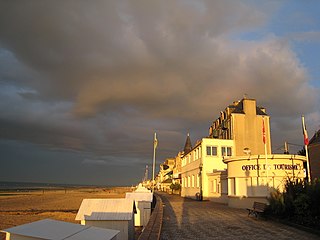
Saint Aubin-sur-Mer is a commune in the Calvados department, in northwestern France. Administratively, it is part of the arrondissement of Caen and the canton of Courseulles-sur-Mer. It is 2.1 km east of Bernières-sur-Mer, 4 km north of Douvres-la-Délivrande and 16 km north of Caen.

The landing craft, tank (LCT) was an amphibious assault craft for landing tanks on beachheads. They were initially developed by the Royal Navy and later by the United States Navy during World War II in a series of versions. Initially known as the "tank landing craft" (TLC) by the British, they later adopted the U.S. nomenclature "landing craft, tank" (LCT). The United States continued to build LCTs post-war, and used them under different designations in the Korean and Vietnam Wars.

Hobart's Funnies is the nickname given to a number of specialist armoured fighting vehicles derived from tanks operated during the Second World War by units of the 79th Armoured Division of the British Army or by specialists from the Royal Engineers.

The landing craft, vehicle, personnel (LCVP) or Higgins boat was a landing craft used extensively by the Allied forces in amphibious landings in World War II. Typically constructed from plywood, this shallow-draft, barge-like boat could ferry a roughly platoon-sized complement of 36 men to shore at 9 knots (17 km/h). Men generally entered the boat by climbing down a cargo net hung from the side of their troop transport; they exited by charging down the boat's lowered bow ramp.

DD or Duplex Drive tanks, nicknamed "Donald Duck tanks", were a type of amphibious swimming tank developed by the British during the Second World War. The phrase is mostly used for the Duplex Drive variant of the M4 Sherman medium tank, that was used by the Western Allies during and after the Normandy Landings in June 1944.

The 79th Armoured Division was a specialist armoured division of the British Army created during the Second World War. The division was created as part of the preparations for the Normandy invasion on 6 June 1944, D-Day.

The Warship Preservation Trust was based in Birkenhead, Wirral, England and hosted Europe's largest collection of preserved warships.

The 27th Armoured Brigade was an armoured brigade of the British Army that served in the Second World War and played a crucial role in the Normandy landings on 6 June 1944 and the following Battle of Normandy until disbandment in late 1944.
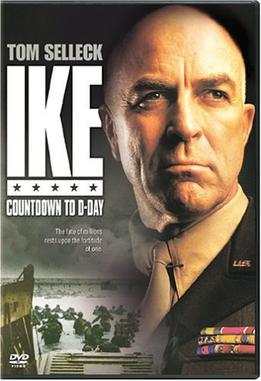
Ike: Countdown to D-Day is a 2004 American made-for-television historical war drama film originally aired on the American television channel A&E, directed by Robert Harmon and written by Lionel Chetwynd. Countdown to D-Day was filmed entirely in New Zealand with the roles of British characters played by New Zealanders; the American roles were played by Americans.

USS LST-494 was a United States Navy amphibious tank landing ship that saw combat during World War II in both the European and Pacific Theaters of War. LST stands for Landing Ship, Tank.
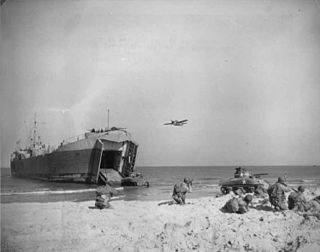
USS Berkshire County (LST-288) was an LST-1-class tank landing ship built for the United States Navy during World War II. Named for Berkshire County, Massachusetts, she was the only U.S. naval vessel to bear the name.

The National Museum of the Royal Navy was created in early 2009 to act as a single non-departmental public body for the museums of the Royal Navy. With venues across the United Kingdom, the museums detail the history of the Royal Navy operating on and under the sea, on land and in the air.

An amphibious warfare ship is an amphibious vehicle warship employed to land and support ground forces, such as marines, on enemy territory during an amphibious assault.

HM LCT 7074 is the last surviving Landing Craft, Tank (LCT) in the UK. LCT 7074 is an amphibious assault ship for landing tanks, other vehicles and troops on beachheads. Built in 1944 by Hawthorn Leslie and Company, Hebburn, the Mark 3 LCT 7074 was part of the 17th LCT Flotilla during Operation Neptune in June 1944.
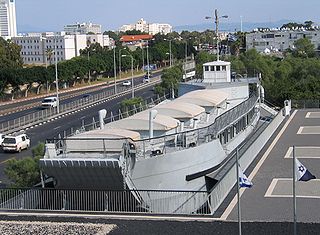
LCT 147 is an amphibious assault ship for landing tanks, other vehicles and troops on beachheads. Built in 1941 by Stockton Construction, Thornaby-on-Tees, the Mark 2 LCT 147 took part in the Invasion of North Africa in June 1943. The ship was converted to a Landing Craft Rocket at Portsmouth Dockyard from March through May 1943 and renamed LCT(2)(R) 147.





















